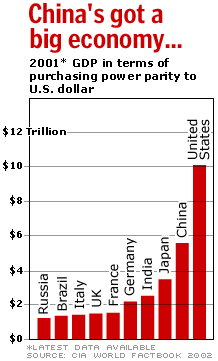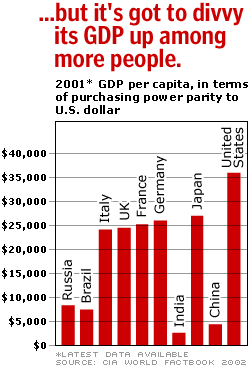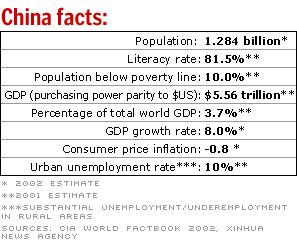NEW YORK (CNN/Money) - Amid a stagnant global economy, one nation, China, is blissfully growing to beat the band, stirring hope -- and even striking some fear -- in the hearts of business executives, economists and policy-makers.
But even as China's impact on the world economy grows, it's far from ready to unseat the United States as the engine of global growth.
At the World Economic Forum in Davos, Switzerland, last week, Zhu Min, economic adviser to the president of the Bank of China, told attendees that 15 percent of world economic growth and nearly 60 percent of world export growth in 2002 came from China.

This followed a Chinese government report that China got more than $50 billion in foreign investment in 2002, to go along with its rip-roaring 8 percent annual GDP growth.
Much gushing ensued.
"China is the hope of Davos," Morgan Stanley chief economist Stephen Roach, a WEF attendee, wrote from the forum. "A weakened global economy needs a new push, and China was offered up as the strongest potential candidate."
China's gross domestic product (GDP), the broadest measure of a nation's economy, ranks behind that of the United States, Japan and a few key European nations when measured in traditional terms, and its official GDP and other economic data are considered by some analysts to be unreliable.
But when measured in terms of purchasing parity with the U.S. dollar -- a method economists use to better reflect the value of a country's currency -- China's GDP ranks second in the world. And few doubt its growth -- whether 8 percent a year or not -- is outpacing the rest of the world.
Some economists worry that rather than "pushing" the global economy, as Roach described it, China could actually be "shoving" it.
China's outrageously strong export growth isn't accompanied by strong import growth, meaning it takes business from foreign manufacturers without generating much domestic demand of its own. China taketh away, but giveth not.
"China will be as big of a force as all the Euro economies put together within the next four-to-five years, and in terms of global trade, it's having a dominant influence now," said BMO Nesbitt Burns senior economist Douglas Porter.
Cheap goods, labor
Imports from China already account for a large portion of the U.S. trade deficit. In the first 11 months of 2002, the latest data available, America's trade gap with China was a whopping $93.6 billion, compared with $62.9 billion with Japan and $73.3 billion for all 15 nations of the European Union.
China's relentless output of cheaply made goods depresses prices for goods made elsewhere, one reason why U.S. consumers see prices falling for many goods, though prices for services such as health care and education are steadily rising.

"China is a big reason why there's such a split between service-price inflation and goods-price inflation in almost every major country you can look at," Porter said.
Meanwhile, China's currency, the yuan, is considered by most economists to be undervalued, making Chinese goods even cheaper relative to those of other nations. Because China's government ties the yuan to the dollar, China gains even more of an advantage when the greenback falls, as has been the case lately.
China is also becoming a major source of super-cheap labor, making it a threat to other developing nations such as Mexico and India. Some economists have long fretted that China could even swallow U.S. jobs, as well.
Back in 2000, when the debate raged about whether the United States should establish permanent normal trade relations with China and help it join the World Trade Organization, economist Robert Scott of the Economic Policy Institute (EPI), a liberal think-tank in Washington, predicted the move would create "sizeable job losses" in the following decade.
Scott estimated that the U.S. trade deficit with China would grow 80 percent between 1999 and 2010, resulting in the loss of about 827,000 U.S. jobs from "every state and ... virtually every sector of the economy," though he noted 85 percent of those would come from manufacturing.
Though Scott hasn't updated his estimates since China joined the WTO in November 2001, another EPI economist, Josh Bivens, noted that the U.S. trade gap with China has already grown about 20 percent between 1999 and 2001 -- a hint that, if anything, Scott's initial estimates might have been too conservative.
"If China's growth was based on its own domestic demand growth, it could be good for the United States," Bivens said. "But the general pattern is that they run really large trade surpluses, which means fewer jobs in U.S. manufacturing."
That's not exactly music to the ears of the nearly 2 million U.S. factory workers laid off during the manufacturing sector's recent long slump.
Pervasive poverty, brittle banks
In order for China's growth to more closely resemble that of the United States, which fuels the global economy by gobbling up imports, the Chinese will have to get wealthier, and thus develop a bigger appetite for goods.
Such upward mobility could be a long time in coming -- about 10 percent of China's approximately 1.3 billion people live below the poverty line, and its $5.56 trillion GDP in 2001 translates to only about $4,300 a person -- a far cry from U.S. per capita income that year of $36,300.
In fact, China's per capita GDP ranked below that of other developing Asian nations, including Brunei, Taiwan, South Korea, Malaysia and Thailand.

"With a population of more than 1 billion and wealth spread throughout the country, penetration of products in China is a problem for anyone who wants to do business there," said Anindya Chatterjee, Asian emerging markets strategist at IDEAglobal.
Chatterjee and other analysts noted other hurdles to China's growth, including persistent deflation -- consumer prices dropped 0.8 percent in 2002 -- and a regulatory environment that, while improving, is still restrictive.
Most worrisome, however, is a banking system in dire need of fixing. China's banks -- which have long been forced to loan to government-owned businesses, whether those businesses are loan-worthy or not -- have about $500 billion in uncollectable loans on their books, according to some estimates.
It's a problem that draws scary comparisons with Japan, whose wretched banking system continues to hinder that nation's ability to pull itself out a decade-long economic slump.
"They're setting themselves up to make the same mistakes Japan did," said Vincent Colicchio, manager of the $11 million China Region Opportunity Fund of U.S. Global Investors. "Their level of bad loans as a percentage of GDP is quite high, and China's putting more money into the banks without requiring them to foreclose on the bad loans -- the same thing Japan did for many years."
But Colicchio prefers to take a longer view of China's prospects, comparing this volatile time in its history with the 19th-century railroad boom that transformed the U.S. economy, with sometimes painful results.
"We had a lot of recessions along the way, severe ones, along with a lot of fraud, a big collapse in the stock market and a nasty depression -- but we got through it," Colicchio said. "China could have some of that too, but in the longer term, in the next 10 years, they'll be the best growth market of all the major economies, for sure."

|

